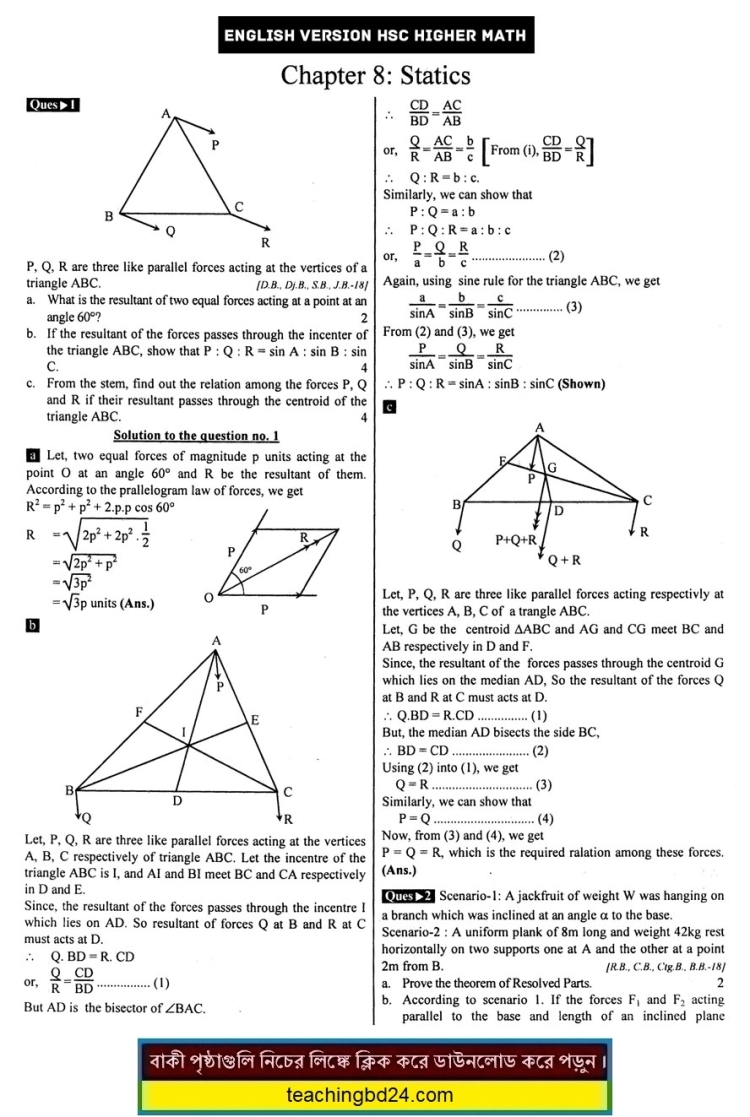HSC EV Higher Mathematics 2nd Paper 8th Chapter Note
HSC EV Higher Mathematics 2nd Paper 8th Chapter Note. Statics. Statics is the branch of mechanics that is concerned with the analysis of loads (force and torque, or “moment”) acting on physical systems that do not experience an acceleration (a=0), but rather, are in static equilibrium with their environment. When in static equilibrium, the acceleration of the system is zero and the system is either at rest or its center of mass moves at constant velocity. The application of Newton’s second law to a system gives:
HSC EV Higher Mathematics 2nd Paper 8th Chapter Note. Statics


The static equilibrium of a particle is an important concept in statics. A particle is in equilibrium only if the resultant of all forces acting on the particle is equal to zero. In a rectangular coordinate system, the equilibrium equations can be represented by three scalar equations, where the sums of forces in all three directions are equal to zero. An engineering application of this concept is determining the tensions of up to three cables under load, for example, the forces exerted on each cable of a hoist lifting an object or of guy wires restraining a hot air balloon to the ground.
The complex number system can be defined as the algebraic extension of the ordinary real numbers by an imaginary number i. This means that complex numbers can be added, subtracted, and multiplied, as polynomials in the variable I, with the rule i2 = −1 imposed. Furthermore, complex numbers can also be divided by nonzero complex numbers. Overall, the complex number system is a field.
Most importantly the complex numbers give rise to the fundamental theorem of algebra: every non-constant polynomial equation with complex coefficients has a complex solution. This property is true of the complex numbers, but not the reals. The 16th-century Italian mathematician Gerolamo Cardano is credited with introducing complex numbers in his attempts to find solutions to cubic equations.
Determinants occur throughout mathematics. For example, a matrix is often used to represent the coefficients in a system of linear equations, and the determinant can be used to solve those equations, although more efficient techniques are actually used, some of which are determinant-revealing and consist of computationally effective ways of computing the determinant itself. The use of determinants in calculus includes the Jacobian determinant in the change of variables rule for integrals of functions of several variables. Determinants are also used to define the characteristic polynomial of a matrix, which is essential for eigenvalue problems in linear algebra. In analytic geometry, determinants express the signed n-dimensional volumes of n-dimensional paralleled. Sometimes, determinants are used merely as a compact notation for expressions that would otherwise be unwieldy to write down. When the entries of the matrix are taken from a field (like the real or complex numbers), it can be proven that any matrix has a unique inverse if and only if its determinant is nonzero. Various other theorems can be proved as well, including that the determinant of a product of matrices is always equal to the product of determinants; and, the determinant of a Hermitian matrix is always real.
Is actually a polynomial because it’s possible to simplify this to 3x + 1 –which of course satisfies the requirements of a polynomial. (Remember the definition states that the expression ‘can’ be expressed using addition, subtraction, multiplication. So, if it’s possible to simplify an expression into a form that uses only those operations and whose exponents are all positive integers…then you do indeed have a polynomial equation)
teachingbd24.com is such a website where you would get all kinds of necessary information regarding educational notes, suggestions and questions’ patterns of school, college, and madrasahs. Particularly you will get here special notes of physics that will be immensely useful to both students and teachers. The builder of the website is Mr. Md. Shah Jamal Who has been serving for 30 years as an Asst. Professor of BAF Shaheen College Dhaka. He expects that this website will meet up all the needs of Bengali version learners /students. He has requested both concerned students and teachers to spread this website home and abroad.

